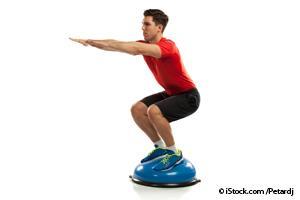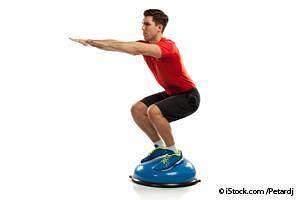Basic BOSU Squats May Change the Way You See Squats
The primary muscles engaged in squatting are your legs and hips. However, while those are primary, your gluteal muscles, transverse abdominis, adductors and soleus muscles in your core are also activated and working hard to balance your body.
This one exercise, whether you do it with added weights or on the BOSU ball, may be considered essential to your strength training program. It is relatively simple to perform and delivers significant benefits no matter how old you are.
When squats are done on the BOSU ball, you have the added benefit of placing greater stress on your core muscles, thus increasing strength. The ball works on improving both your balance and flexibility as you work though the different levels of doing squats, from beginner to advanced.
This deceptively simple piece of equipment is relatively inexpensive, can be easily stored at home and may expand the scope of your exercise program and improve your overall results.
Advantages and Disadvantages of Not Being Balanced
One of the benefits of using a BOSU ball for exercise, especially squatting, is that you’re are doing the exercise on an unstable platform. This engages more of your muscles to perform the movement. These are the same muscles needed to maintain your balance as you grow older.
In a study from Perelman School of Medicine at the University of Pennsylvania, researchers demonstrated a link between people who exhibited difficulty doing activities of daily living, such as rising out of a chair, or bending to tie their shoes, and the length of their life.1
The goal was to develop a functional way of staging the activity limitations to predict lifespan and recommend changes that may increase longevity.
They evaluated over 9,000 people over the age of 70 and found the median life expectancy was greater than 10 years for those with minor limitations in their activity level, but only just over a year for those who were significantly limited.2
The researchers recommended improving balance and flexibility to increase the ability to perform daily movements and activities. This is exactly how the BOSU ball may help your squat routine — through improving your strength and balance.
While balance is a benefit to doing squats on the BOSU ball, drastic improvements in strength are not. It is unsafe to use added weight with dumbbells or a weighted barbell on the BOSU ball, as the instability of the ball makes handling added weight dangerous.
However, if strength training is your goal, your body needs both core muscle activation and leg strengthening to work optimally. So, while doing weighted squats on the ball is dangerous, incorporating several sets on the BOSU into your routine may improve your overall performance when you are using weights.
BOSU May Be Your Rehab Tool After an Injury
BOSU balls are used by physical therapists to improve strength, stability and balance in their patients. In a study published in the Journal of Strength and Conditioning Research, scientists found an unstable surface used during maximum effort squats would help maintain the activation of muscles in the lower limbs and trunk.3
Their conclusion was that using an unstable surface during a squat may benefit you as part of a rehabilitation program, as the muscles activated and strengthened are achieved under a reduced load capacity, reducing the potential for further injury.
Another study in the International Journal of Sports Physical Therapy found similar results.4 These researchers found the characteristics of working on an unstable surface was not beneficial to strength or power training for athletes, but were advantageous in a rehabilitation environment.
The force placed on muscle during exercise on an unstable surface was of sufficient intensity for a recuperating muscle or injury-susceptible joint.5
In this study, researchers recommended an unstable surface, such as the BOSU ball for rehabilitation of lower back pain conditions. This no-load balance training improves the strength and conditioning of your lower back muscles, important in your ability to perform everyday movements.
These exercises may also help you prevent lower back pain by improving strength and balance even if you have not suffered an injury.
Squats Are An Important Part of Your Fitness Routine
Squats are a vital component of your exercise routine, and using a BOSU ball is one way of taking full advantage of the benefits of this exercise.
Squats work the muscles in your core and legs, and doing them on the BOSU ball also work your upper body and shoulders as you make tiny alterations in your weight distribution to remain balanced on the ball.
Squats are functional exercises, or training done in a manner that improves strength or balance that directly improves your performance of daily living activities.6
Since the squat also builds strength and muscle balance in some of your little used muscle groups, this exercise also improves your athletic performance and reduces your risk of injury. Improvements you make to your large muscle groups in your legs translates into being able to jump higher and run faster.7
Doing this multi-purpose exercise on the BOSU improves the strength in your core muscle that participate in the regulation of glucose and lipid metabolism and insulin sensitivity, helping to protect you against obesity, diabetes and cardiovascular disease.
Executing squats also improves your ability to squat over the toilet. Squatting was how your ancestors performed bodily functions until the middle of the 19th century when sit down toilets became available to the general public.
However, squatting is far better, as it places your intestines in the proper position for emptying your bowels, and sitting may have contributed to the prevalence of several health conditions.
Sitting during a bowel movement has been implicated in diverticulitis, constipation, appendicitis and hemorrhoids.8 Squatting toilets are healthier for your colon and easier to achieve when you practice squats on the BOSU ball.
3 Levels of the BOSU Squat
You can practice beginner, intermediate or advanced squats on the BOSU ball, each higher level working your legs and core muscles to a greater degree. In this one-minute video, personal trainer Jill Rodriguez demonstrates the beginner, intermediate and advanced techniques you can use at home.
When you are using the BOSU ball for the first time, place it near a wall you can reach with your hand if you start to lose your balance and can’t recover. Give yourself time to learn how to balance on the ball before starting to do squats. While Rodriguez makes it look easy, if you’ve never been on the BOSU before, it can take a few days to get your balance.
Beginner and intermediate moves are done on the soft side of the ball. You might have thought standing on the solid side would be easier, but instead your weight increases the instability of the ball while standing on the flat surface, making the movements much more difficult.
Beginning squats on the soft side of the BOSU ball are done much like they are done on the floor. Try to keep your feet flat, body stable, hips out and knees behind your toes, not extending beyond your toes. Intermediate squats are done like the beginner squats with an added hop between repetitions. Hopping on the ball requires you develop the skill and balance, so don’t start with these, even if you are adept at squats on solid ground.
Advanced squats are done on the flat side of the BOSU ball. As you raise and lower your body you’ll experience greater instability under your feet requiring more engagement in your core and hips. While Rodriguez performs these seemingly effortlessly, you’ll want to evaluate your form to ensure you do them correctly.
How to Correct Common Squatting Mistakes
In this video, personal trainer James Wilson explains some of the problems you may have in performing a standard squat on solid ground. Two common errors when performing a squat are:
- Placing your bottom over your heels and your knees past your toes when you sink down into the squat. Proper form starts with bending at the hips, not at the knees, pushing your bottom out past your heels, making sure to stop before your knees go past your toes.
- Rounding your back as you lower your body. Wilson describes this as “tucking your tail” when your hamstrings are too tight and your abs aren’t strong enough to brace your lower back. Poor body mechanics may also include raising your shoulders first as you rise, instead of the movement originating from the hips.
Learn proper form on the floor before you begin using the BOSU ball for squatting to ensure you don’t develop more muscle problems than you solve. Doing squats with poor form may increase your potential for injury to your knees, hips and lower back. Often your poor form is related to tight hip flexors and hamstring muscles. This may cause your knees to travel past your toes, putting more stress on the knee joint and increasing your risk for injury.
It is more important to perform the movements correctly to get the benefits than it is to count the number of incorrectly performed squats that may increase your risk of knee or lower back pain.
Read More..Comments
There are 0 comments on this post













